| Author |
Message |
|
Ben Sweet
|
 Posted: Wed 05 Dec, 2012 4:51 pm Post subject: A collection of chainmail Posted: Wed 05 Dec, 2012 4:51 pm Post subject: A collection of chainmail |
 |
|
|
Can I get members here who own any type of chainmail to post up a close up photo of that chainmail with any US or foreign coin laying on top of that chainmail please let me/us know who made it, specs on the rings, and where it was purchased, thanks!
|
|
   |
 |
Luka Borscak

|
 Posted: Thu 06 Dec, 2012 11:15 am Post subject: Posted: Thu 06 Dec, 2012 11:15 am Post subject: |
 |
|
|
I welcome the idea.
|
|
  |
 |
|
Sean Manning
|
 Posted: Fri 07 Dec, 2012 8:41 pm Post subject: Posted: Fri 07 Dec, 2012 8:41 pm Post subject: |
 |
|
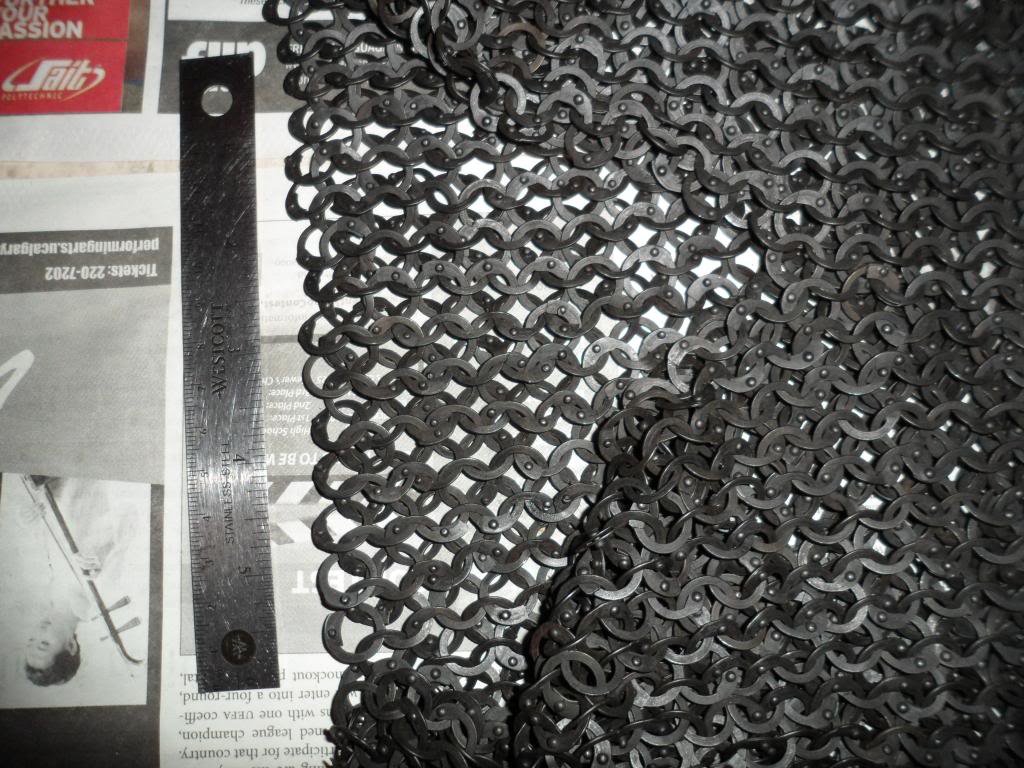
Type of rings: Blackened mild steel, 9 mm inner diameter, 13 mm outer diameter, about 0.7 mm thick (I don't have good enough instruments to measure), flat cross section, all rings closed with rivets shaped like dumb-bells.
Importer: IceFalcon Armoury
Year of Purchase: 2012
Compared to the Sinigaglia, Westwale, and Hearst Collection hauberks the ring size is about right but the rings are too thin and flat. The rivet holes appear to be circular and punched. For a "ten-foot test" the main problem is that it is blackened, since I am not aware of any sources for that from 14th century Europe. But I knew that when I ordered it ...
|
|
  |
 |
Dan Howard

|
 Posted: Sat 08 Dec, 2012 11:34 am Post subject: Posted: Sat 08 Dec, 2012 11:34 am Post subject: |
 |
|
|
Not sure about the "ten foot test". Even when watching TV I can tell which mail was made in India. The lapped join and especially the very thin links make them very distinctive even from a distance.
|
|
  |
 |
|
Sean Manning
|
 Posted: Sat 08 Dec, 2012 12:55 pm Post subject: Posted: Sat 08 Dec, 2012 12:55 pm Post subject: |
 |
|
Maybe you have better eyes than I do. My disillusionment with forum threads on maille was completed when I spent five or so hours studying maille in the Glenbow and realized that at 1 m in museum lighting, its hard to tell whether maille is half or fully riveted. Even telling whether it is butted or riveted can be hard unless you are quite close or the light is good. That said, a good example of how period maille could look close up, to contast with modern Indian replicas, is Wade Allen's photo of a 16th century mail shirt. The less flat rings and less conspicuous rivets of the historical armour are very visible there.
It also hangs on the body differently than 14th century European maille would, since its made of “joined tubes” not tailored row by row. But as far as I know, all Indian mail has that problem.
|
|
  |
 |
Dan Howard

|
 Posted: Sat 08 Dec, 2012 1:23 pm Post subject: Posted: Sat 08 Dec, 2012 1:23 pm Post subject: |
 |
|
|
The main visual problem is the very thin links and exaggerated lapping. As you said, from a distance it is hard to tell whether individual links are even riveted or not. Personally I think that, from a distance, the PVC mail used in the Lord of the Rings looks better than the Indian mail. Whenever I see Indian mail it makes me think of soda can ring tabs.
|
|
  |
 |
Mark T

|
 Posted: Sat 08 Dec, 2012 1:40 pm Post subject: Posted: Sat 08 Dec, 2012 1:40 pm Post subject: |
 |
|
Ben,
Here are some images of the various types of mail made by one of the main Indian manufacturers: http://www.snexports.com/chainmaille-armour-detail.html
Chief Librarian/Curator, Isaac Leibowitz Librarmoury
Schallern sind sehr sexy!
|
|
  |
 |
|
Ben Sweet
|
 Posted: Tue 11 Dec, 2012 7:11 pm Post subject: Posted: Tue 11 Dec, 2012 7:11 pm Post subject: |
 |
|
Thanks Sean for posting up your photo.
Thanks Mark for that link.
B
|
|
   |
 |
|
Peter Johnsson
Industry Professional
|
 Posted: Wed 12 Dec, 2012 3:46 am Post subject: Posted: Wed 12 Dec, 2012 3:46 am Post subject: |
 |
|
Here is another example of antique mail. I do not know its age or origin, but it might be 15th or 16 th century European. It has been cut to shape, rather roughly, for use in the near east. The rings are tightly riveted. I have tried to pry apart a few, but it is not possible to force even a very sharp and strong edge into the overlapping ends.
The overlap is tight to the point of almost looking like it is welded, and the wedge shaped rivets are small. Every other row is unriveted. Cross section of the wire is slightly oval. Diameter of the wire is about 1.8 x 1.4 mm (but vary in every part of every ring) outer diameter of the rings is about 12.4 mm. The rings along the hem and lower end of the arms are worn thinner than those that make up the body of the armour.
 Attachment: 130.96 KB Attachment: 130.96 KB
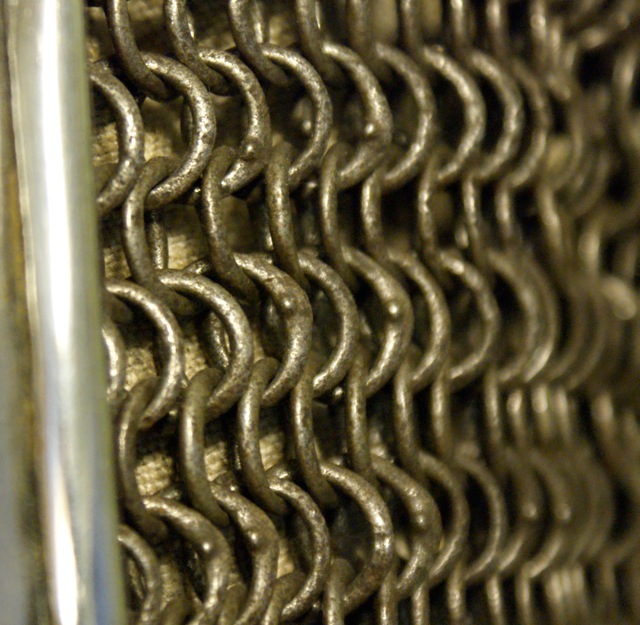
|
|
   |
 |
David Lewis Smith

|
 Posted: Wed 12 Dec, 2012 5:19 am Post subject: Riveted Titanium Chainmail Posted: Wed 12 Dec, 2012 5:19 am Post subject: Riveted Titanium Chainmail |
 |
|
This is not historical maile of course. I bought it with the idea of Ti would be something I would have to perform less maintenance on not have to worry about scrubbing rust off and always have a 'good' appearance on the lists.
What I got was somewhat less than that.
Photo one, when the maile arrived it had holes in it, new out of box. I ran out of both spoons and patients marking the holes for the photo
The second two photos are closeups
The shirt was replaced quickly unfortunately it was the same riveting job and now I am stuck with a $1900 pile of rings that can not be used as the rivets come apart and the merchant refuses to refund my money.
 Attachment: 128.44 KB Attachment: 128.44 KB
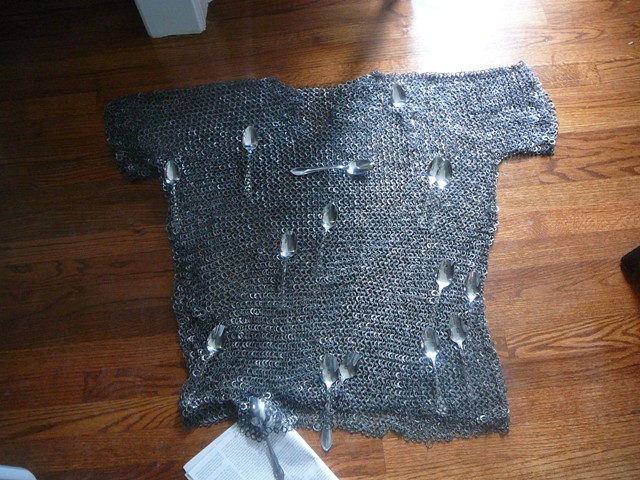
spoons marking the holes
 Attachment: 112.82 KB Attachment: 112.82 KB
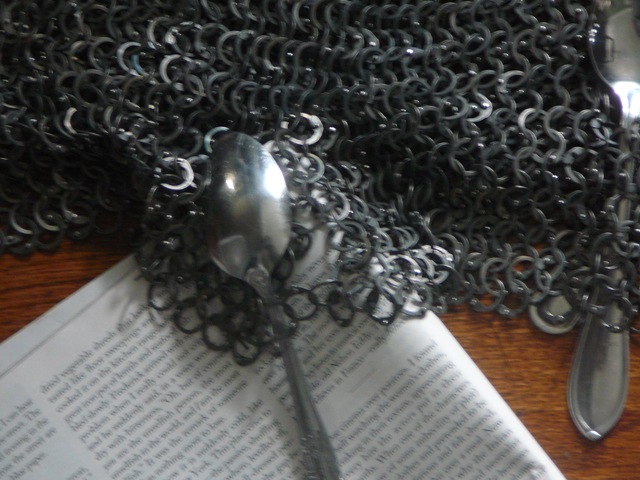
large holes in the 'new' maile
David L Smith
MSG (RET)
|
|
   |
 |
Luka Borscak

|
 Posted: Wed 12 Dec, 2012 2:38 pm Post subject: Posted: Wed 12 Dec, 2012 2:38 pm Post subject: |
 |
|
Who is the manufacturer? The community has the right to know. 
|
|
  |
 |
|
Mart Shearer
|
 Posted: Thu 11 Jul, 2013 10:42 am Post subject: Posted: Thu 11 Jul, 2013 10:42 am Post subject: |
 |
|
| Peter Johnsson wrote: | Here is another example of antique mail. I do not know its age or origin, but it might be 15th or 16 th century European. It has been cut to shape, rather roughly, for use in the near east. The rings are tightly riveted. I have tried to pry apart a few, but it is not possible to force even a very sharp and strong edge into the overlapping ends.
The overlap is tight to the point of almost looking like it is welded, and the wedge shaped rivets are small. Every other row is unriveted. Cross section of the wire is slightly oval. Diameter of the wire is about 1.8 x 1.4 mm (but vary in every part of every ring) outer diameter of the rings is about 12.4 mm. The rings along the hem and lower end of the arms are worn thinner than those that make up the body of the armour. |
Most of the current research seems to indicate that half-riveted (demi enclous, demi clouere, diversis clavaturis) construction ended around the mid-14th century. Thom Richardson proposes c. 1340. If I understand from previous posts from Erik Schmid, wedge riveting was likely adopted in late 13th or early 14th century Germany and Flanders.
Of course t doesn't seem unusual for older pieces to be cut-up, re-used, or modified. Nor is it unusual for sleeves and skirts to be made of lighter wire than the front of the body.
ferrum ferro acuitur et homo exacuit faciem amici sui
|
|
  |
 |
Jeff A. Arbogast

|
 Posted: Thu 11 Jul, 2013 1:45 pm Post subject: Posted: Thu 11 Jul, 2013 1:45 pm Post subject: |
 |
|
Here are a few pics of the handmade aventail on the helmet that Thorkil made for me a few years back. I don't have any specs on it but the dime will give you some idea. I also don't know why it is so black, it just came that way, I did not order it like that or anything. But I prefer it anyway, and it has not developed a bit of rust on it anywhere, although I do wipe it down from time to time just to make sure. It is strong and very well made but it is also very light and flows like silk. It actually has a rather pleasant feel, the way it just drapes nicely over the shoulders without any kinking or binding. And best of all, no pulled beard hairs! Not once! Try that with most mail, especially butted.
One of Thorkil's buddies, (Pawel) does this for him in Poland. It is made up of alternating rows of riveted round rings and flat punched rings but you have to get very close to even notice that. It is not clunky or clumsily made at all. I would love to get a mail coat one day to match, when finances allow.
 Attachment: 171.57 KB Attachment: 171.57 KB
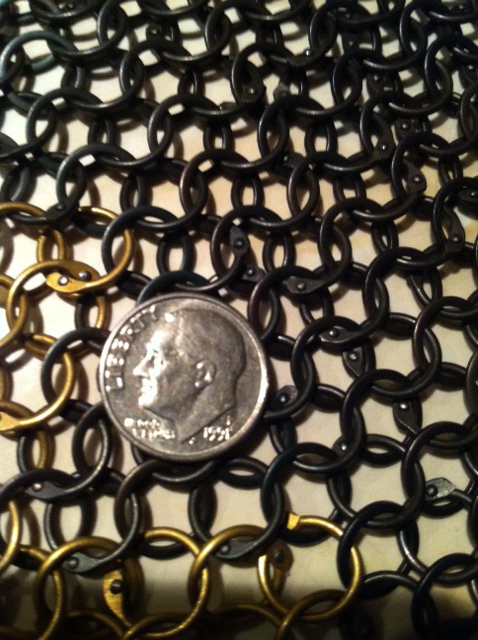
 Attachment: 141.88 KB Attachment: 141.88 KB

 Attachment: 123.85 KB Attachment: 123.85 KB
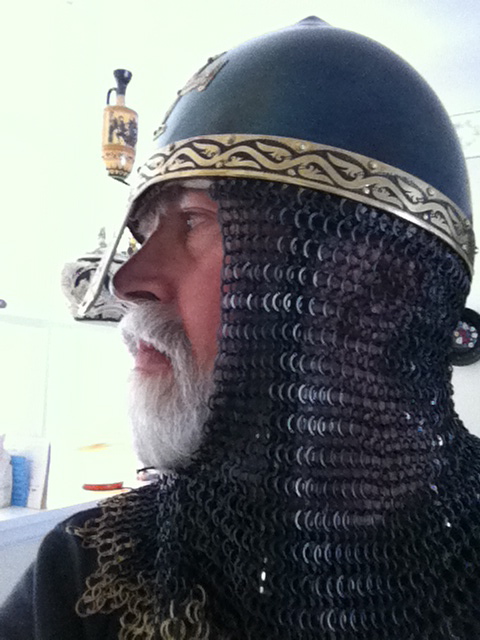
A man's nose is his castle-and his finger is a mighty sword that he may wield UNHINDERED!
|
|
  |
 |
|
|

